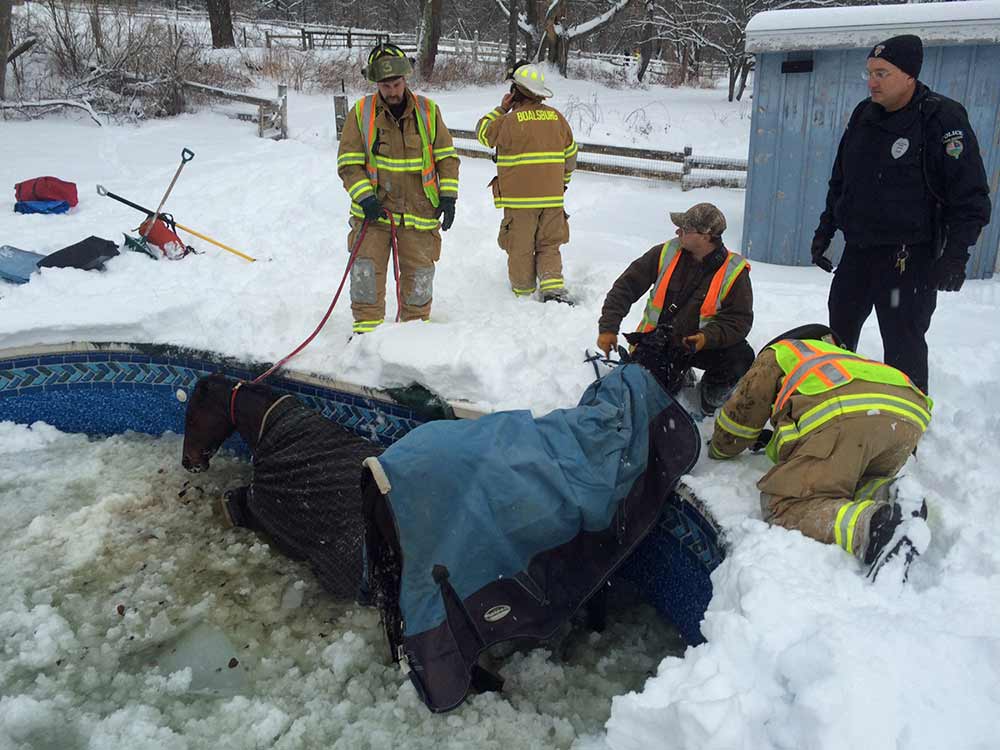
A horse whinnying loudly alerted homeowners in Harris Township, PA that something was amiss early Tuesday morning, January 27. A light snow was falling. The temperature hovered around 20 degrees. It was definitely not a good day for a dip in the pool. But a mare and a filly somehow got out of their fenced pasture that morning and broke through the pool cover. Their companion, who remained in the pasture, in all likelihood saved the horses’ lives by making a commotion. “Probably because of the snow fall they meandered out onto the pool and couldn’t tell that they were on the pool,” Kyle Schmoeller says. He works with Centre County’s LifeLink EMS, and was on the scene as the Boalsburg fire and rescue personnel worked to get the horses out of the pool.
The horses were in the deep end of the pool, struggling amid chunks of broken ice. First responders on the scene called for backup from the County Animal Response Team (CART).
“We asked if they had drained the pool,” Brenda Coe says, “but they said the horses had cut the liner, so the pool was draining itself.” Coe is a volunteer with CART in Centre County. “They had some problems, because there were about four inches of ice.” She says they were in the process of constructing steps using pallets and plywood. The pool had no steps they could use.
Within an hour, the two horses were out of the pool and back in their barn. “We got there with lifts,” Coe says, “but they were able to get them out using the pallets.”
A Teachable Moment
Water rescues are not uncommon, and first responders are confident and well-prepared to rescue people and even small animals like dogs from water and ice. But the gut-wrenching sight of two horses struggling in freezing water was a wake-up call. Schmoeller says that the two horses, exhausted and shivering, managed to climb onto an ice shelf, where they calmed down a bit. He says that the horses cooperated with rescuers, but there is a lot that he wants to learn about helping large animals in emergencies.
He says he has registered for a Large Animal Rescue Training (LART) course that Coe’s group is holding in March at Penn State. “Every year for the past three years, we’ve had incidents of horses or cows in ponds, or loose on the highway,” Coe says. She says that each county in Pennsylvania has a CART team, trained to respond along with other emergency groups to situations like the one in Boalsburg. But these rescues are complex and dangerous for both animal and rescuer. That’s why the specialized training is so important.
Preparing for Success
Coe says that her group has been trying to attract more people to the training programs because Pennsylvania’s agricultural and equine industries are so important, and animals don’t always stay where they’re supposed to stay. They wander, like the Boalsburg horses, and often get in trouble.
But large animals are also involved in other emergencies such as fires and floods. A dog or cat that is frightened can pose dangers for rescuers. But a panicked horse or cow can be lethal to someone who doesn’t know enough about animal behavior. The LART course, which will take place over two weekends in March, will include both classroom instruction and hands-on work for participants.
The topics will include farm incident management, animal behavior and handling, foreign animal diseases/biosecurity and zoonotics, animal first aid, emergency euthanasia, professionalism and liability issues. In addition, participants will learn how to move large animals to safety in emergencies such as trailer accidents, water rescues, etc. Those interested in signing up should email the Program Director at Penn State, deh27@psu.edu.




